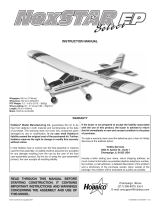
6
Flying Precautions
WARNING
Never grasp the transmitter antenna while ying.
■ The transmitter output may drop drastically.
Always make sure that all transmitter stick move-
ments operate all servos properly in the model prior to
flight. Also, make sure that all switches, etc. function
properly as well. If there are any diculties, do not use
the system until all inputs are functioning properly.
Never y in range check mode.
■ In the dedicated range test range check mode, the transmitter
output range is reduced and may cause a crash.
While operating, never touch the transmitter with, or
bring the transmitter near, another transmitter, a cell-
phone, or other wireless devices.
■ Doing so may cause erroneous operation.
Do not point the antenna directly toward the aircraft
during ight.
■ The antenna is directional and the transmitter output is
weakest. (The strength of the radio waves is greatest from the
sides of the antenna.)
Never y on a rainy day, when the wind is strong, or
at night.
■ Water could lead to failure or improper functionality and poor
control of the aircraft which could lead to a crash.
Never turn the power switch o during ight or while
the engine or motor is running.
■ Operation will become impossible and the aircraft will crash.
Even if the power switch is turned on, operation will not begin
until transmitter and receiver internal processing is complete.
Do not start the engine or motor while wearing the
neck strap.
■ The neck strap may become entangled with the rotating
propeller, rotor, etc. and cause a serious injury.
Do not fly when you are physically impaired as it
could pose a safety hazard to yourself or others.
Do not y at the following places:
■ Near another radio control ying eld.
■ Near or above people.
■ Near homes, schools, hospitals or other places where people
congregate.
■ Near high voltage lines, high structures, or communication
facilities.
When setting the transmitter on the ground during
ight preparations, do not stand it upright.
■ The transmitter may tip over, the sticks may move and the
propeller or rotor may rotate unexpectedly and cause injury.
Do not touch the engine, motor, or ESC during and
immediately after use.
■ These items may become hot during use.
For safety, y so that the aircraft is visible at all times.
■ Flying behind buildings or other large structures will not only
cause you to lose sight of the aircraft, but also degrade the RF
link performance and cause loss of control.
From the standpoint of safety, always set the fail safe
function.
■ In particular, normally set the throttle channel to idle. For a
helicopter, set the throttle channel to maintain a hover.
When flying, always return the transmitter setup
screen to the Home screen.
■ Erroneous input during ight is extremely dangerous.
Always check the remaining capacity of the trans-
mitter and receiver batteries before each ying session
prior to ight.
■ Low battery capacity will cause loss of control and a crash.
Always check operation of each control surface and
perform a range test before each flying session. Also,
when using the trainer function, check the operation of
both the teacher and student transmitter.
■ Even one incorrect transmitter setting or aircraft abnormality
can cause a crash.
Before turning on the transmitter:
1. Always move the transmitter throttle stick position to the
minimum (idle) position.
2. Turn on the transmitter rst and then the receiver.
When turning off the transmitter’ s power switch
after the engine or motor has stopped (state in which it
will not rotate again):
1. Turn o the receiver power switch.
2. Then turn o the transmitter power switch.
■ If the power switch is turned on/off in the opposite order, the
propeller may rotate unexpectedly and cause a serious injury.
■ Also always observe the above order when setting the fail safe
function.
When adjusting the transmitter, stop the engine ex-
cept when necessary. In the case of a motor, disconnect
the wiring that allows it to continue operation. When
doing so, please exercise extreme caution. Ensure that
the aircraft is secured and that it will not come into con-
tact with anything or anyone. Ensure that the motor will
not rotate prior to making any adjustments.
■ Unexpected high speed rotation of the engine/motor may
cause a serious injury.






















